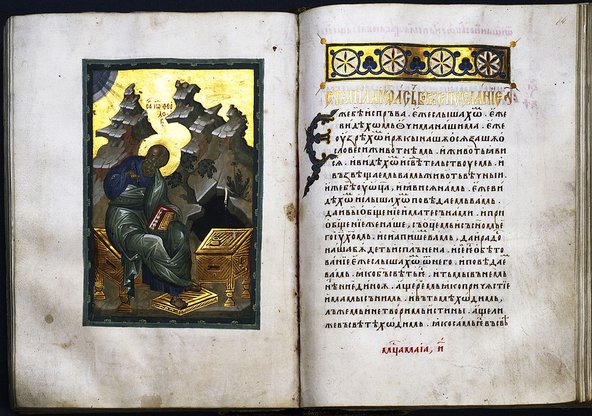What Is the Basis for the Writings of the New Testament?
It is easy to forget that the earliest Christians did not yet have the New Testament. They had the Scriptures of Judaism – what is now called the Old Testament – but they had no writings of their own until Paul started to write to the churches he had founded, some time in the 50s AD, a couple of decades after the crucifixion of Jesus. The gospels were not written till later still, probably in the 70s-90s AD. Until then, the stories about Jesus and his sayings must have circulated orally. A generation or two of Christians thus managed without a written record of Jesus. In 'New Testament times', there was no New Testament.

Agreeing on the gospels
How did the individual letters and gospels come to be regarded as holy scripture, alongside the older corpus of the Old Testament or Hebrew Bible? In The Da Vinci Code , Dan Brown popularised the theory that it was not until the fourth century that the Church decided what was to be in the New Testament, selecting from a vast body of gospels and other books that had been written by Christians of various persuasions.
In particular, he claimed that the Church authorities conspired to suppress many gospels that presented Jesus in very human terms and had a positive view of the body, in favour of an altogether more ethereal idea of Christianity and its founder. Until then, he asserted, Christian scripture had been much more of a free-for-all. Thus the turning point for the Christian faith lay in the second half of the fourth century, when 'orthodox' bishops tendentiously excluded 'heretical' writings from the Christian biblical canon, at councils such as Laodicea (363 AD), Rome (382 AD), and Hippo (393 AD). The mood was summed up in the 39th Festal Letter of bishop Athanasius, in 367 AD, which listed exactly the books that now form the New Testament as the only ones to be accepted and believed.
Like so many conspiracy theories, Brown's is fatally flawed. There were indeed a good many gospels besides the four now in the New Testament, but they were almost all much later in origin than the canonical ones, the sole possible exception being the Gospel of Thomas – a collection of Jesus' sayings that includes some not now in the New Testament. There are also letters and apocalypses – that is, books purporting to offer revelations from God in the same way as the Book of Revelation – claiming to come from various apostles, but they are also from the late second century at the earliest. These texts are occasionally cited by early Christian writers, but overwhelmingly less than the books that found their way into the New Testament. Like the decisions of the various councils, Athanasius' Letter is not innovative but records the books on which Christians were already agreed – with just a small penumbra of doubt about a few marginal cases such as the second and third Letters of John.
Between significance and scripture
The turning point, at which our present New Testament books ceased to be occasional writings and became scripture, was really in the second century. By the time of Justin Martyr (ca. 100-165 AD) and Irenaeus (ca. 130-202 AD) we find extensive quotations from New Testament books; while the First Letter of Clement, addressed to the church in Corinth, quotes Paul's First Letter to the Corinthians.
Within the New Testament itself there is already a hint that Paul's letters are coming to be regarded as scriptural, like the Old Testament: the second Letter of Peter, a canonical though pseudonymous work probably from the late first century, says that there are obscurities in Paul's writings which perverse people twist to their own liking 'as they do the other scriptures' (2 Peter 3:16). By the 240s, Origen (184-253 AD) could write a commentary on the Gospel according to Matthew, just as he also wrote one, for example, on the Old Testament book of Joshua. By then Matthew was, simply, Scripture. Quotations from what we know as the New Testament far outweigh those from works later rejected as heretical. To cope with that, any conspiracy theory would need to show that the works of a host of Christian writers had been heavily redacted by 'orthodox' editors.

There was certainly a stage before the now-canonical gospels and epistles were seen as parts of the Bible. Between being written in the first century and coming to be regarded as scripture in the latter half of the second, there was a time when they were not yet cited using formulae such as 'it is written', which marks out quotations from the Old Testament. They were seen as something different from Old Testament Scripture, because they were known to be recent works. But their newness made them if anything more, rather than less, important than the old scriptures, and there are early second-century works that actually cite them more than they do the Old Testament.
Acceptance into 'The Bible'
The distinction between scripture – old, venerable and of Jewish origin – and the books that would come to form the New Testament, is most vividly apparent in the fact that the latter were not written on scrolls, but in codices. The codex was an informal vehicle, something like a notebook in status, which did not catch on as a form of text for high-level writings until well after this. But Christians used it from the beginning for their own works, as if to assert that these were not 'biblical', even though they were of enormous importance for the nascent Church.
Thus, there are four stages in the formation of the New Testament. The books were written a considerable time after the time of Jesus himself. In the early second century they were regarded as hugely significant, in some ways more so than the Old Testament, yet they were not themselves 'scripture'. By the end of that century they were coming to be treated as parts of a bipartite Bible consisting of Old and New Testaments. And finally, in the fourth century, ecclesiastical writers began to list them formally, recognising decisions already taken in the past that these were the Christians' own scriptures. The major turning point lies in the second century shift towards scriptural status for these books: the fourth-century rulings do little more than acknowledge formally what was already in practice the case. There was no conspiracy.
John Barton FBA is the author of A History of the Bible: The Book and Its Faiths (Allen Lane, 2019). He is Emeritus Oriel & Laing Professor of the Interpretation of Holy Scripture in the University of Oxford.
What Is the Basis for the Writings of the New Testament?
Source: https://www.thebritishacademy.ac.uk/blog/how-new-testament-was-created/
0 Response to "What Is the Basis for the Writings of the New Testament?"
ارسال یک نظر